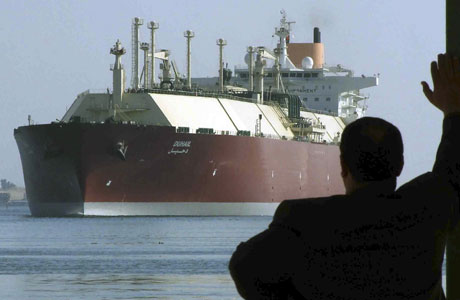

LNG armada could revolutionize industry
COMMENT: Given recent news that the LNG "boom" is bust, none of these floating LNG factory ships will ever get built. That notion is expressed toward the end of this article, and it may be realistic.
There's an interesting context for BC. A second Kitimat LNG project crept into BC quietly this year. LNG Partners is proposing to take surplus BC gas, ship it through the Pacific Northern Gas (PNG) pipeline and liquify it on one of these floating LNG ships, which would be anchored near Kitimat in Douglas Channel. The LNG would then be offloaded to LNG tankers for shipment to Pacific Rim and perhaps other markets.
The company had a deal with PNG approved by the BCUC in November, and was going to secure capacity on the PNG system on December 15, 2008 with a $1.5 million option payment. The payment hasn't happened, and PNG's one reason for optimism in recent years appears to have leaked away, as yet another LNG project slinks out, as quietly as it came in.
See also:
LNG Partners does not make payment to PNG
LNG Partners books pipeline capacity with PNG
By Tom Bergin
Calgary Herald
December 23, 2008
Ships would produce gas while at sea
 A man looks as the world's biggest Liquefied Natural Gas (LNG) tanker DUHAIL as she crosses through the Suez Canal April 1, 2008. Photograph by: Herald Archive A man looks as the world's biggest Liquefied Natural Gas (LNG) tanker DUHAIL as she crosses through the Suez Canal April 1, 2008. Photograph by: Herald Archive |
Oil and gas companies are racing to develop a new type of vessel they hope will revolutionize offshore gas production, but even if the untested technology works, its deployment could be blocked by resource holders who fear it will undermine development goals.
The industry hopes to build a fleet of ships or barges that can sail or be towed to offshore gas discoveries, extract gas, freeze it to liquefied natural gas (LNG) and off-load the LNG to tankers for shipping to lucrative Western and Asian markets.
Anglo-Dutch oil major Royal Dutch Shell PLC is leading the charge, but U. S. rivals ExxonMobil and Chevron and Australia's Woodside are also eyeing floating LNG, or FLNG.
Companies hope FLNG will be cheaper than building onshore liquefaction facilities, speed up the time it takes to bring fields on-stream, reduce projects' environmental footprints and make it economic to exploit small and remote offshore deposits.
Such deposits represent over a sixth of global gas reserves, builder Costain, which offers FLNG design services, says on its website.
Producing gas without touching the host nation's soil would also reduce security risks, which is why Shell wants to use the technology in Iraq --even though the reserves are onshore--and why several players want to use FLNG in Nigeria.
"FLNG has the potential to be a real revolution in the LNG industry," Stephen Craen, an energy banker at Societe Generale, told a conference last month.
FLNG could also be a boon for shipyards and equipment makers because the vessels may be the most expensive oceangoing craft ever built--even costlier than the U. S.'s latest Nimitz-class aircraft carriers, which cost around $4.5 billion US each, according to the U. S. navy's website.
"There's a lot of excitement about FLNG at the moment," Frank Harris head of global LNG at industry consultants Wood Mackenzie, said.
Plans for FLNG vessels vary from a ship-like design proposed by U. K.-based startup FlexLNG, that would produce 1.5 million tonnes per year (TPA), to barge-like structures being pursued by Shell and others, that could produce up to 5 million tonnes a year.
The larger vessels will likely cost about $1,000 per tonne per year to build, Harris said, suggesting costs of around $5 billion each.
This is in line with onshore costs but will avoid the need for separate offshore production platforms and up to hundreds of kilometres of piping --potentially saving billions.
FLNG vessels are also forecast to be quicker to build than onshore plants--3.5 years compared to eight to 10 years, analysts at Citigroup said in a research note earlier this year.
This is partly because offshore facilities can avoid the lengthy permitting processes associated with building onshore. FLNG has less impact on animal habitats and avoids the need to move communities, proponents say.
The permitting advantage has also led to plans to develop floating facilities for importing LNG. ExxonMobil wants to use a floating regasification terminal offshore New Jersey, but its experience is a note of caution to those who expect floating LNG production to offer big cost savings.
"It's more expensive but it may be the only way to do it environmentally or to get permitting," Neil Duffin, head of Exxon's project development unit said, of the New Jersey project.
Even if FLNG is proven to work and be cost effective, its deployment may be limited by resource holders' fears the technology means gas discoveries do not spur economic growth.
As FLNG vessels will likely be built in developed countries such as Korea, no construction jobs will be created locally.
Some less developed African and Asian countries also fear the use of floating LNG may discourage companies from piping gas ashore to provide energy for domestic industries.
However, analysts caution that even after more than a decade of research and the recent flurry of industry conferences and consultants' reports on floating LNG, it may still be years off anyone actually building a floating liquefaction vessel.
"We've yet to see anybody pull the trigger on an FLNG project yet,"Harris said.
© Copyright (c) The Calgary Herald
Posted by Arthur Caldicott on 23 Dec 2008